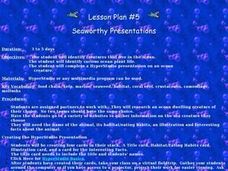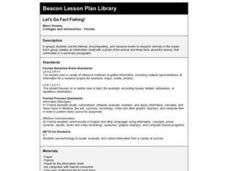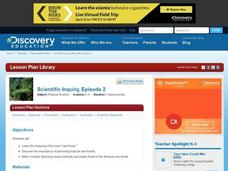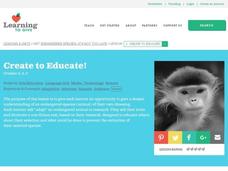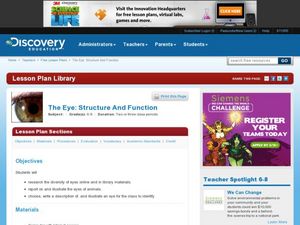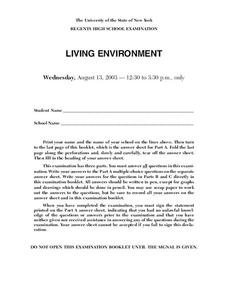Curated OER
Seaworthy Presentations
First graders research ocean animals and plants on the web. In this ocean habitat lesson, 1st graders prepare a multimedia presentation. Students will work on their presentations in pairs and every group should have its own...
Curated OER
Let's Go Fact Fishing!
Learners work in pairs to research animals in the ocean. They use the Internet, encyclopedias, and resource books to complete an information sheet with a photo of the animal and three facts. They present their mini-reports to the class.
Curated OER
Safari Sentence Scramble
Students use real life experiences for writing. In this identifying details lesson plan, students use information such as colors, numbers, sizes, shapes and locations to write sentences about the zoo. Students position the words...
Alabama Learning Exchange
Edible Cell
Students identify cell parts and their function. In this animal cell lesson plan, students view a video clip and discuss cell components. Students create an edible replica of an animal cell using food items.
Curated OER
Create an Illuminated Alphabet Word Book
Students create a class alphabet book. In this letter recognition lesson, students use line and color to draw an object whose name begins with a specific letter. Students use adjectives to create a sentence describing the object or...
Curated OER
Listen and Draw
Students use their visualizing and interpreting skills to produce original writings and drawings. First, they listen to an adaptation of William Clark's description of the sage grouse. They form mental images that they translate into...
Curated OER
Hatched From An Egg
Students discover how animals are born/hatched. In this life science lesson, students listen to a book entitled Chickens Aren't The Only Ones, and discuss animals that are hatched or born. Students receive a picture of an animal,...
Curated OER
Activity Plan 5-6: S.O.S. - Save Our Species!
Students create a banner or flag about an endangered animal to teach others about their plight for survival. For this environmental science lesson plan, the class will work to create a list of endangered animals, then create a class...
Curated OER
African Wildlife
Students investigate the wildlife of Africa. In this animal science lesson, students view the video "National Geographic's African Wildlife" and visit websites to research additional information on the wildlife of Africa. Students...
Curated OER
Tell About Your Hero and Publish the Essay Online
In this writing about your hero worksheet, students read stories about personal heroes at an assigned web site that were written by other students. They think about their own hero, write an essay, and follow directions for publishing it...
Curated OER
The Unique Rain Forest
Young scholars explore the unique Rain Forest. In this Rain Forest lesson, students watch a video about the dangers the Rain Forest faces. Young scholars create a Rain Forest mobile. Students choose plants or animals from the...
Curated OER
Chow
In this reading comprehension worksheet, young scholars read a four paragraph story. After reading, students answer five multiple choice, three short answer, and six fill in the blank questions about the story. They also write a...
Curated OER
Endangered Species... It's Not Too Late
Students choose an endangered species to research and report on. In this endangered species lesson, students complete a worksheet to gather information about their endangered animal and then use to write a book about the animal and...
Curated OER
Sea Horse Body Parts
Students complete a diagram of sea horse body parts. In this sea horse activity, students review the story Sea Horses A True Book, complete a sea horse diagram using Internet sights to help, make new entries in their KWL charts and...
Curated OER
The Eye; Structure and Function
Students research the structure and function of the eye. In this anatomy lesson plan, students write a report about the eye and draw an illustration. They research a particular animal's eye then present their findings to the class...
Curated OER
Polar Bear Literacy Activity
Students generate vocabulary words synonymous or related to "noise." In this literacy instructional activity, students listen to the book Polar Bear, Polar Bear, What do You Hear? by Bill Martin and Eric Carle and discuss the meaning of...
Curated OER
Cellular Invaders
In this biology worksheet, students study the animation on how the body's defense mechanism fight microbes. They write short answers to 8 questions that follow.
Curated OER
Levels of Classification
Learners use diagrams to compare structural differences that taxonomists use to classify animals. In this classification lesson plan, students compare structures of different species from given diagrams. In one diagram they identify the...
Curated OER
Living Environment
For this environment worksheet students complete a series of multiple choice questions and short answers on plant and animal species and populations in an ecosystem.
Curated OER
Living Environment
In this environmental lesson students complete a series of multiple choice and short answer questions on animal populations, cell structure and chromosomes.
Curated OER
Chicago: The City in Art, 1995-2000
Students examine a mural of animals and talk about animal classification. They act as scientists and keep a record, called a Jungle Journal, of plants and animals they observe while studying the rainforest.
Curated OER
Amazing Australia (Grade K)
Students listen as the teacher reads "Possum Magic" to them. They watch the movie of the book, and create a T graph illustrating the differences and similarities between the book and movie. They research an animal and print a picture in...
Curated OER
Pet by Pet by Pet
In this ordinal number worksheet, 3rd graders examine the order of animals shown in a row at the top of the page. They answer questions that describe the position of each pet using ordinal numbers in 7 examples including 1 writing problem.
Curated OER
Enemies and Threats to Sea Horses
Learners research threats and enemies of the sea horse. In this animal biology lesson, students use the Internet to find threats and enemies of sea horses and write a paragraph on their findings.
